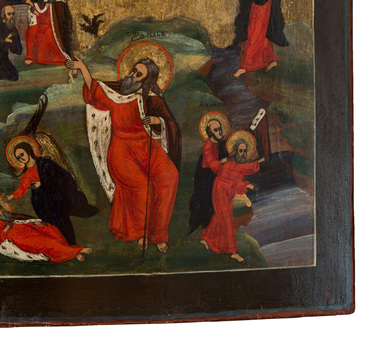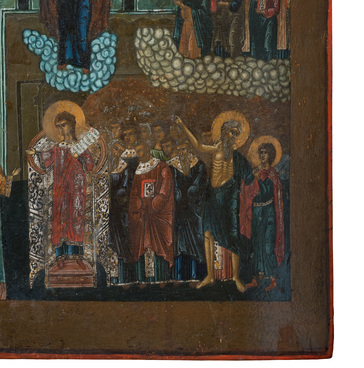“The Coronation of the Most Holy Theotokos” is a rare subject in Russian iconography, as it is not Orthodox in origin: the Bible does not mention the coronation of the Mother of God.
Western European artists borrowed the attributes of the composition from the literary work “Golden Legend”, popular in the Middle Ages. It was written in the 13th century by the Dominican monk Jacobus de Voragine. He researched and compiled reliable hagiographies of saints, as well as apocrypha and folk tales and legends. This work was copied by hand for centuries, and with the advent of printing, it was reprinted many times. It has also been translated into almost all European languages.
According to Catholic tradition, the coronation of the Virgin took place after Her assumption and ascension to Heaven. Catholics celebrate the Coronation as a separate holiday. Orthodox Christians do not observe such a holiday, but they do celebrate the Assumption of the Virgin.
The subject of the “coronation” spread to the Western Russian lands, which had been under Polish rule for centuries, and was primarily popular in the Uniate Church (which was under Catholic influence, but retained the Church Slavonic characteristic of Orthodox Christianity for divine services and rituals). This iconographic type was subsequently adopted by Orthodox icon painters. Most of the Uniates, after the return of the Western Russian lands to the Russian state during the late 18th — mid 19th centuries, returned to traditional Orthodoxy, but at the same time preserved many Uniate teachings borrowed from Catholicism, part of which was the veneration of the icon “The Coronation of the Most Holy Theotokos”.
The image is non-canonical, because God the Father is depicted as an elder. Such an image is prohibited by the rulings of the general council, as God the Father has never appeared to mankind in this form.
The plot of the icon is rather simple: Christ and God the Father, sitting on clouds, lower a golden crown on the head of the Virgin Mary; the Holy Spirit hovers over them, represented as a dove. In early Catholic icons of this type that date back to the 12th century, the coronation of the Mother of God is performed by Christ alone.
The faces and the folds of the robes are
meticulously detailed. Contrasting chiaroscuro effects in the clouds and rays
of heavenly radiance also serve as an additional stage decoration.


